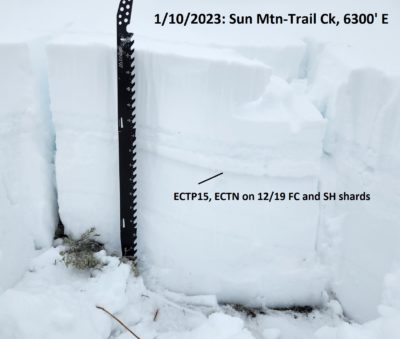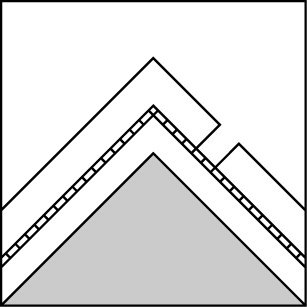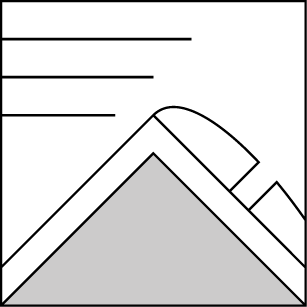Basic Information
Observation Details
Observation Date:
January 10, 2023Submitted:
January 10, 2023Observer:
SAC - Scott SavageZone or Region:
Soldier and Wood River Valley MtnsLocation:
Sun Mtn - mostly Trail Ck drainage (6000-7600': mostly S-SE-E and some SW, W, and NE)Signs of Unstable Snow
Recent Avalanches?
None ObservedCracking?
IsolatedCollapsing?
IsolatedSnow Stability
Stability Rating:
GoodConfidence in Rating:
ModerateStability Trend:
SteadyBottom Line
I did not experience any obvious signs of instability. The snow surface was wind-affected and stiffened above about 7000', but there were no wind slabs where I traveled. There is a layer of facets and small surface hoar shards (on some slopes) about 25-50cm deep (1-1.5 feet) that I don't trust, mainly in wind-affected terrain.
Advanced Information
Weather Summary
Cloud Cover:
ObscuredTemperature:
20s FWind:
LightNew/Recent Snowfall:
HST=about 20cm Snow flurries began around 3 PM, intensified around 4 PM, and deposited 2cm by 4:45.Skies began OVC and became OBSC. Recent winds moved snow above about 7000' here but did not form many wind slabs. There is still a decent amount of snow available for transport.
Snowpack Observations
Thin, 70-110cm snowpack where I traveled. On solars (S-SW), the snowpack was thin and pole probes indicated the 12/19 layer was below or barely above the "sage line" on sheltered slopes. The 12/19 layer presents as a crust+FC combo on solars and a FC/SH layer (SH in shards, not standing upright) on E aspects. The 12/19 layer (25-50cm deep) was the most concerning, especially on E aspects where the FC and SH were better developed.
Immediately above 12/19, the snowpack is a mess with 2-4 crusts of varying thickness and a mishmash of FC, mixed forms, melt-freeze, and sporadic percolation columns in between the crusts. Nothing around the crusts jumped out at me as especially worrisome where I traveled today, mainly due to the impressive variability as you changed aspect and/or elevation.
The 11/27 layer near the ground was thin here, likely too thin to overcome roughness from local terrain and vegetation. The large FC were moist and showing signs of rounding.
Snowpit photos: sheltered terrain at 6300' E, wind-affected terrain at 7200' E


Avalanche Problems
| Problem | Location | Distribution | Sensitivity | Size | Comments |
|---|---|---|---|---|---|
 Persistent Slab
Persistent Slab
|
|
Layer Depth/Date: 25-50cm (12/19) and upper snowpack Comments: Shaded area indicates where I traveled most of today. The weak layer is widespread, but the problem is more worrisome on recently wind-affected or loaded slopes where there is a "meatier" slab.12/19 appeared to be worst on E aspects here, where SH was present. Solars had a more prominent crust+FC structure at 12/19, and it didn't look or "behave" as badly. |
|||
 Wind Slab
Wind Slab
|
|
Unknown |
Layer Depth/Date: 20-30cm Comments: Shaded area indicates where I traveled. Visibility was terrible when I was on the ridge, but I didn't encounter any true wind slabs. That being said. the wind had moved snow and formed drifts on the ridge at 7400-7600'. I'm reasonably confident it formed wind slabs in terrain "favored" by S-SE winds in upper elevation terrain. |
Terrain Use
I was traveling solo and stayed out of avalanche terrain.

